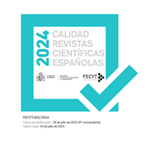Elementos para la construcción del escenario del candidato político en Instagram. El caso de las elecciones generales del 28 de abril de 2019 en España
Resumen
En Instagram, el candidato tiene la oportunidad de manejar los elementos del escenario en el que se representa para transmitir a los potenciales votantes una estudiada imagen de sí mismo. En esta investigación se analizan los elementos con los que se muestran en Instagram los cinco principales candidatos a la presidencia del gobierno español. El objetivo principal es determinar si ha existido un cambio de estrategia significativo durante el periodo electoral del 28 de abril de 2019. Para ello, a partir de la operacionalización del concepto de setting de Goffman (1956), se utiliza una metodología cuantitativa sobre una muestra total de 473 posts. Los resultados muestran un cambio de estrategia en el modo de construir el escenario en Instagram conforme se acercan las elecciones generales: los candidatos muestran un perfil más profesional y menos humanizado.
Descargas
Descarga artículo
Licencia
La revista Estudios sobre el Mensaje Periodístico, para fomentar el intercambio global del conocimiento, facilita el acceso sin restricciones a sus contenidos desde el momento de su publicación en la presente edición electrónica, y por eso es una revista de acceso abierto. Los originales publicados en esta revista son propiedad de la Universidad Complutense de Madrid y es obligatorio citar su procedencia en cualquier reproducción total o parcial. Todos los contenidos se distribuyen bajo una licencia de uso y distribución Creative Commons Reconocimiento 4.0 (CC BY 4.0). Esta circunstancia ha de hacerse constar expresamente de esta forma cuando sea necesario. Puede consultar la versión informativa y el texto legal de la licencia.










